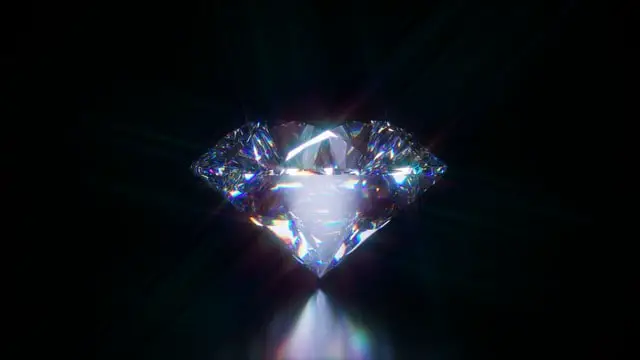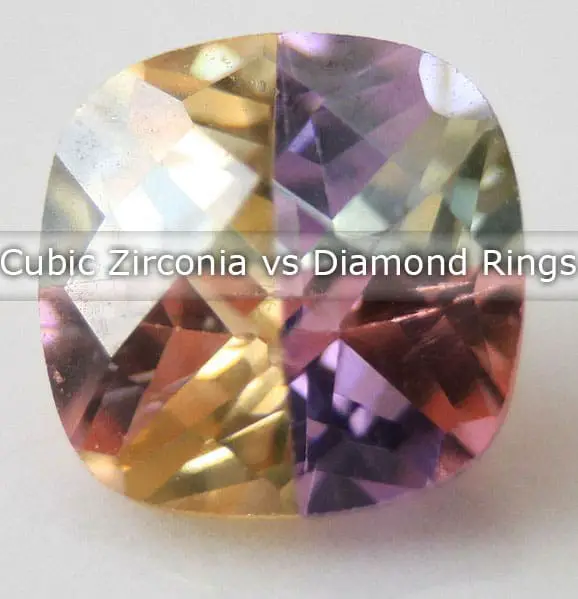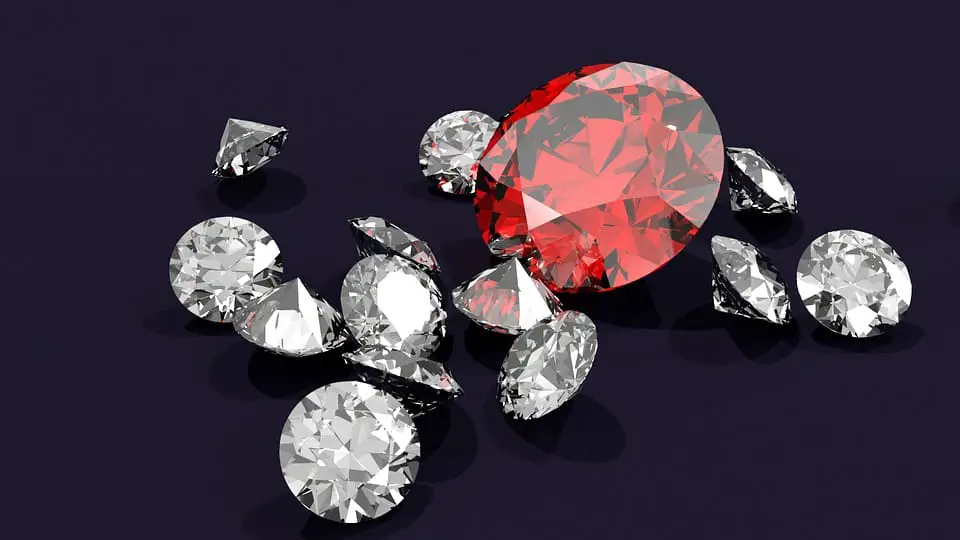Table of Contents
*This post may contain affiliate links. As an Amazon Associate we earn from qualifying purchases.
Cubic Zirconia vs Diamond Rings: What You Need to Know
As you head to the jeweler’s to shop for your engagement and wedding rings, you’ll be with a lot of options in color, cut, and type of gemstone.
It may seem overwhelming, especially when you’re trying to decide on what material you want your gemstones cut from.
Do you want diamonds? What about cubic zirconia? What is the difference?
This handy guide will help you decide exactly what kind of ring you want to buy for your beloved.
Cubic Zirconia vs Diamond Rings: Know First About Cubic Zirconia
Cubic Zirconia is a lab-created gemstone that looks very similar to real diamonds but is actually very different in its make-up and features.
It is the crystalline form of zirconium dioxide and is made entirely in a lab. The process for creating it in a lab setting was perfected in the 1970s, and it began to be sold worldwide as a popular substitute for diamonds in engagement rings and other jewelry.
To the untrained eye, it looks so similar that most cannot tell the difference between cubic zirconia and the real thing.
What are the Differences?
Diamonds Gem Crystal Ruby Gemstone Diamond
Hardness
Cubic zirconia is not as hard as a real diamond and isn’t as resistant to heat, meaning that it can crack under high temperatures in a way that diamonds cannot.
This lesser hardness also means that cubic zirconia is easier to scratch and will lose its luster over time.
If you decide to buy a ring with cubic zirconia gemstones, keep in mind that you’re going to need to be more careful with those rings. Regular special care of those rings will keep them looking great, but might not be a great choice if you or your partner plan to wear them regularly.
Diamond is the hardness natural material known to man, which is one of the reasons why it works so well when set into jewelry pieces.
Daily wear jewelry has less of a risk of being scratched or losing its shine over the years.
Density
Diamonds weigh a little less than cubic zirconia (CZ), and that is because the man-made material in a CZ gemstone is denser than a real diamond.
If your ring has a larger cubic zirconia gemstone, then you might notice a slight difference in the way, but it’s barely noticeable and likely won’t be an issue.
Color
Cubic zirconia can be made to be completely colorless, which in turns gives it a higher quality look.
Diamonds are found naturally and are often colored with a yellow or brown tinge due to the levels of nitrogen in the material.
Truly colorless natural diamonds are usually rare, as it means they’re free of flaws. A colorless diamond is usually of the highest quality and will cost significantly more than the synthetic CZ gemstone.
Dispersion and Refractivity
Dispersion and refractivity indexes are both factors that play into how the gemstone shines and refracts light.
Cubic zirconia has a higher dispersion factor, meaning that it will sparkle and reflect light more than a diamond.
A diamond has a higher refractivity index, however, which means this captures the light better and ultimately looks more brilliant than cubic zirconia.
Price
The price of diamonds is usually significantly higher due the need to mine them before they can be cut into the shapes that you see in engagement rings the world over. The higher quality the diamond – the size, color (or lack of color), and cut – the more expensive they tend to be. A flawless 1-carat diamond can be sold for thousands of dollars.
Cubic zirconia is manufactured, so rarity isn’t a factor in determining the price of the gemstone. A flawless 1-carat cubic zirconia gemstone can be bought for less than $10, with larger stones looking just as beautiful but not breaking your bank.
This discrepancy in price is especially poignant given the recent invention of man-made diamonds that aren’t mined but also created in a lab. Natural diamonds are often too expensive for the working man to afford, and man-made diamonds are usually up in the higher price range as well.
When we compare cubic zirconia vs diamond in the price department, cubic zirconia always wins. You’ll still get a beautiful ring even if you’re on a budget.

Cut
Generally speaking, you won’t see much of a difference in the cut between these two stones, but it’s important to bring up either way.
When choosing your engagement ring, the cut of the stone plays a lot into how the light reflects off it and how it’s set into the ring. Cubic zirconia and diamonds can usually be cut into the same types of shapes to create a beautiful ring.
Which One Should I Choose?
It really depends on your personal preferences and the preferences of your partner. If you’re looking for a beautiful engagement ring that doesn’t run up into the thousands, then a ring with cubic zirconia is probably your best choice.
If you’re looking for something that won’t scratch as easily or is more durable in the long run and price isn’t an issue, then a real diamond is the right choice.
Putting a Price on Love
As previously stated, the biggest difference between the two gemstones is their price.
Natural diamonds used to be priced based on their rarity, but the introduction of man-made diamonds has moved the goalposts a little bit. Color, cut, and size of the diamond all play into how its priced.
Often, diamonds of varying sizes are chosen as a signifier of class or status, but the question remains: can you really put a price on love? If you’re not concerned with the price of the ring on your finger, then why not choose the less expensive option?
Conflict-Free Diamonds
Something to consider before you make your diamond ring purchase is the origin of the diamond in your ring.
Conflict or “blood” diamonds are diamonds that are traded illegally out of conflict zones and used to fund wars.
This practice is especially prevalent in central and western Africa. Many of these diamonds are smuggled out of the country in rough form and then cut down to a specific size. You might not know that the diamond you’re buying was traded to fund a conflict in a war-torn area.
Conflict diamonds are generally mined by men, women, and children who are used as slaves in this illegal trade. The diamonds are extracted using back-breaking methods that are often fatal to the people who are forced to perform the work.
By choosing a conflict-free diamond, you are doing your part to keep money out of the hands of those who would like to see the conflicts continue.
You can ensure that the diamonds came out of a conflict-free zone by asking your jeweler for the Kimberley Process certification for each ring that has a diamond set into it.
What is the Kimberley Process?
The Kimberley Process was created in the early 2000s when Southern African diamond-producing states met in Kimberley, South Africa, to find a way to stop the trade in conflict diamonds.
They drafted a binding agreement for every participant with heavy requirements on the sale and trade of rough diamonds and certifies them as conflict-free.
Each participant in the agreement must meet a set of standards for the diamonds they trade and safeguard the transportation of rough diamonds worldwide.
According to their website, the Kimberley Process has helped to disrupt over 98% of the illegal conflict diamond trade and kept the money from that trade out of the hands of rebel factions seeking to undermine legitimate governments in Africa and on other continents.
By choosing a certified conflict-free diamond for your engagement ring, you’re helping to uphold the Kimberley Process in your own small way.
Still Can’t Decide? Try a Different Stone
If you’re still stuck at the jewelry counter and don’t know which side to take in the cubic zirconia vs diamond debate, then try checking out a few pieces that feature other gemstones.
Popular options for engagements rings have been opals (which are beautiful, but a very brittle stone, so tread carefully), rubies, emeralds, and even some sapphires.
Many of those stones have beautiful synthetic alternatives that will keep the price tag low and leave you a little wiggle room in the rest of your wedding planning.
Whatever you decide, at least you’ll be armed with some more facts to make the choices at ring counter seem a little less daunting.


